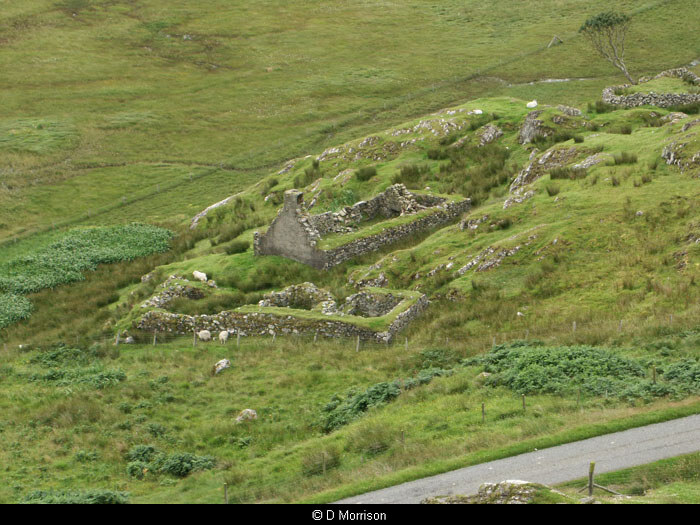16868: The runrig system of land tenure
by Angus “Ease” Macleod, Calbost; from the Angus Macleod Archive, Kershader.
The system of land tenure under which Calbost and the whole of Lewis functioned in earlier times was the old clan system known as run-rig. The crofting system of land tenure which superseded the run-rig system did not come into effect in the Pairc area until the second decade of the 19th century.
The runrig system of land tenure was organised on military lines as might be expected from the clan chiefs whose main preoccupation in life was military. At the top of the structure was the clan chief, the supreme commander as it were, at the next level of command was the tacksmen class or the equivalent of an officer corps. Then there were the small holders or ordinary soldiers.
“Tac” is the old Gaelic word for farm. Tacksmen leased large areas of land from the clan chief on a long-term basis, usually as a reward for military service or because of blood relationships. He, in turn, sub-let most of his land to small holders on an annual lease without security or tenure. The small holders annual rent was therefore payable to the tacksmen and it was usually paid in kind, either by labour or agricultural produce or both. There were no written records of either rent or small holders tenancy kept. Only the tacksmen “na daoine uaisle” were entered in the rent roll.
Under the Run Rig system of tenure no part of the in-bye arable land was held permanently by any individual small holder, but was re-allocated regularly. There was an annual allocation of about one third of the arable land and it was carried out as follows:
Towards the end of the autumn, when the harvest was over, the village constable who was an official elected by the small holders in order to represent them (similar to a grazing clerk) called a meeting of the small holders and the estate representative known as the ground officer or “Maor”. Having decided on the portion of land to be put under the green crop next year, they divided it in shares according to the number of tenants in the village. Thereupon they cast lots, hence the designation “lots” which is still the name sometimes applied to the croft. The share of the land that fell to a tenant was kept by him for three years. In that way a third of the land under cultivation was reallocated each year and the whole of the Tack land changed hands every three years. In that way the good land and the not so good land rotated among all the tenants.
The land round the township was held collectively by al the small holders in the township in the same way as it is today as common grazing under the crofting system. Under the crofting system that superseded the Run Rig tenure system the village constable has given way to the present township grazing committee which is serviced by a grazings clerk. That system was acknowledged statutorily in the 1955 crofters act. The communal aspect of the old runrig system continued into the new crofting system.
Angus Macleod Archive
Details
- Record Type:
- Story, Report or Tradition
- Type Of Story Report Tradition:
- Story
- Record Maintained by:
- CEP
